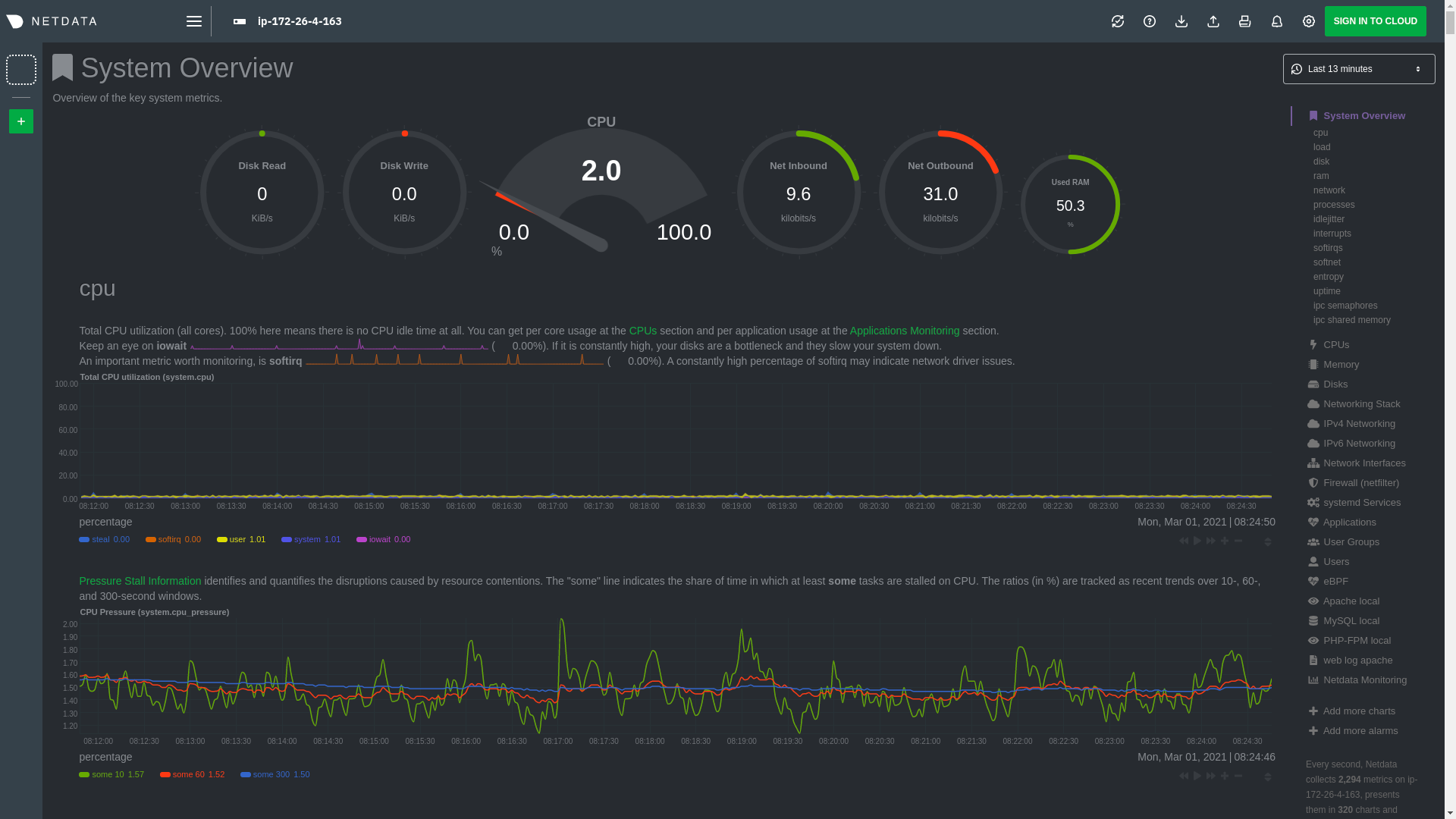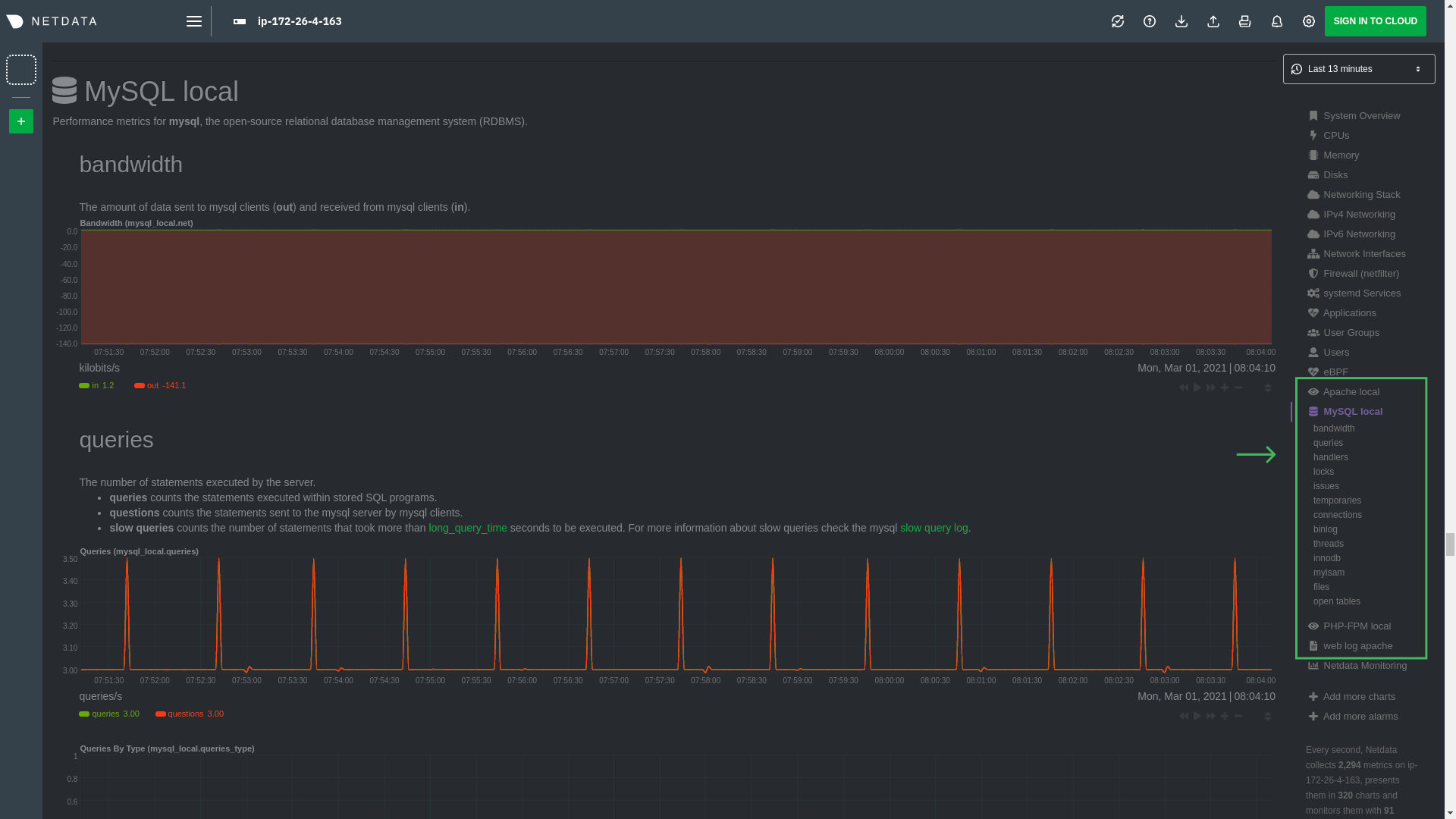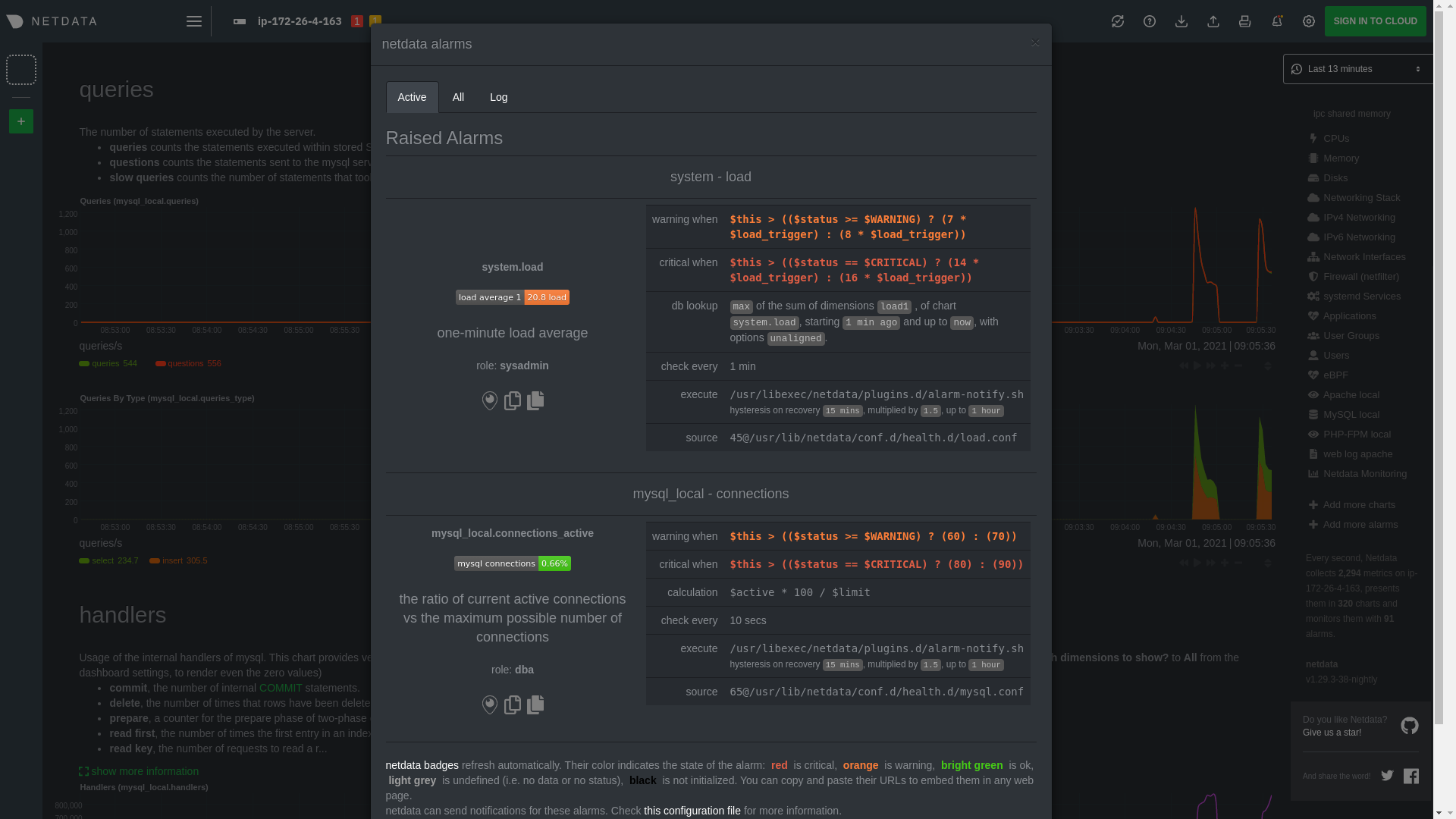mirror of
https://github.com/netdata/netdata.git
synced 2024-11-23 16:17:43 +00:00
238 lines
14 KiB
Plaintext
238 lines
14 KiB
Plaintext
import { OneLineInstallWget } from '@site/src/components/OneLineInstall/'
|
|
|
|
# LAMP stack monitoring with Netdata
|
|
|
|
Set up robust LAMP stack monitoring (Linux, Apache, MySQL, PHP) in a few minutes using Netdata.
|
|
|
|
The LAMP stack is the "hello world" for deploying dynamic web applications. It's fast, flexible, and reliable, which
|
|
means a developer or sysadmin won't go far in their career without interacting with the stack and its services.
|
|
|
|
_LAMP_ is an acronym of the core services that make up the web application: **L**inux, **A**pache, **M**ySQL, and
|
|
**P**HP.
|
|
|
|
- [Linux](https://en.wikipedia.org/wiki/Linux) is the operating system running the whole stack.
|
|
- [Apache](https://httpd.apache.org/) is a web server that responds to HTTP requests from users and returns web pages.
|
|
- [MySQL](https://www.mysql.com/) is a database that stores and returns information based on queries from the web
|
|
application.
|
|
- [PHP](https://www.php.net/) is a scripting language used to query the MySQL database and build new pages.
|
|
|
|
LAMP stacks are the foundation for tons of end-user applications, with [Wordpress](https://wordpress.org/) being the
|
|
most popular.
|
|
|
|
## Challenge
|
|
|
|
You've already deployed a LAMP stack, either in testing or production. You want to monitor every service's performance
|
|
and availability to ensure the best possible experience for your end-users. You might also be particularly interested in
|
|
using a free, open-source monitoring tool.
|
|
|
|
Depending on your monitoring experience, you may not even know what metrics you're looking for, much less how to build
|
|
dashboards using a query language. You need a robust monitoring experience that has the metrics you need without a ton
|
|
of required setup.
|
|
|
|
## Solution
|
|
|
|
In this tutorial, you'll set up robust LAMP stack monitoring with Netdata in just a few minutes. When you're done,
|
|
you'll have one dashboard to monitor every part of your web application, including each essential LAMP stack service.
|
|
|
|
This dashboard updates every second with new metrics, and pairs those metrics up with preconfigured alerts to keep you
|
|
informed of any errors or odd behavior.
|
|
|
|
## What you need to get started
|
|
|
|
To follow this tutorial, you need:
|
|
|
|
- A physical or virtual Linux system, which we'll call a _node_.
|
|
- A functional LAMP stack. There's plenty of tutorials for installing a LAMP stack, like [this
|
|
one](https://www.digitalocean.com/community/tutorials/how-to-install-linux-apache-mysql-php-lamp-stack-ubuntu-18-04)
|
|
from Digital Ocean.
|
|
- Optionally, a [Netdata Cloud](https://app.netdata.cloud/sign-up?cloudRoute=/spaces) account, which you can use to view
|
|
metrics from multiple nodes in one dashboard, and a whole lot more, for free.
|
|
|
|
## Install the Netdata Agent
|
|
|
|
If you don't have the free, open-source Netdata monitoring agent installed on your node yet, get started with a [single
|
|
kickstart command](/packaging/installer/README.md):
|
|
|
|
<OneLineInstallWget/>
|
|
|
|
The Netdata Agent is now collecting metrics from your node every second. You don't need to jump into the dashboard yet,
|
|
but if you're curious, open your favorite browser and navigate to `http://localhost:19999` or `http://NODE:19999`,
|
|
replacing `NODE` with the hostname or IP address of your system.
|
|
|
|
## Enable hardware and Linux system monitoring
|
|
|
|
There's nothing you need to do to enable system monitoring and Linux monitoring with
|
|
the Netdata Agent, which autodetects metrics from CPUs, memory, disks, networking devices, and Linux processes like
|
|
systemd without any configuration. If you're using containers, Netdata automatically collects resource utilization
|
|
metrics from each using the [cgroups data collector](/src/collectors/cgroups.plugin/README.md).
|
|
|
|
## Enable Apache monitoring
|
|
|
|
Let's begin by configuring Apache to work with Netdata's [Apache data
|
|
collector](/src/go/plugin/go.d/modules/apache/README.md).
|
|
|
|
Actually, there's nothing for you to do to enable Apache monitoring with Netdata.
|
|
|
|
Apache comes with `mod_status` enabled by default these days, and Netdata is smart enough to look for metrics at that
|
|
endpoint without you configuring it. Netdata is already collecting [`mod_status`
|
|
metrics](https://httpd.apache.org/docs/2.4/mod/mod_status.html), which is just _part_ of your web server monitoring.
|
|
|
|
## Enable web log monitoring
|
|
|
|
The Netdata Agent also comes with a [web log
|
|
collector](/src/go/plugin/go.d/modules/weblog/README.md), which reads Apache's access
|
|
log file, processes each line, and converts them into per-second metrics. On Debian systems, it reads the file at
|
|
`/var/log/apache2/access.log`.
|
|
|
|
At installation, the Netdata Agent adds itself to the [`adm`
|
|
group](https://wiki.debian.org/SystemGroups#Groups_without_an_associated_user), which gives the `netdata` process the
|
|
right privileges to read Apache's log files. In other words, you don't need to do anything to enable Apache web log
|
|
monitoring.
|
|
|
|
## Enable MySQL monitoring
|
|
|
|
Because your MySQL database is password-protected, you do need to tell MySQL to allow the `netdata` user to connect to
|
|
without a password. Netdata's [MySQL data
|
|
collector](/src/go/plugin/go.d/modules/mysql/README.md) collects metrics in _read-only_
|
|
mode, without being able to alter or affect operations in any way.
|
|
|
|
First, log into the MySQL shell. Then, run the following three commands, one at a time:
|
|
|
|
```mysql
|
|
CREATE USER 'netdata'@'localhost';
|
|
GRANT USAGE, REPLICATION CLIENT, PROCESS ON *.* TO 'netdata'@'localhost';
|
|
FLUSH PRIVILEGES;
|
|
```
|
|
|
|
Run `sudo systemctl restart netdata`, or the [appropriate alternative for your system](/docs/netdata-agent/start-stop-restart.md), to collect dozens of metrics every second for robust MySQL monitoring.
|
|
|
|
## Enable PHP monitoring
|
|
|
|
Unlike Apache or MySQL, PHP isn't a service that you can monitor directly, unless you instrument a PHP-based application
|
|
with [StatsD](/src/collectors/statsd.plugin/README.md).
|
|
|
|
However, if you use [PHP-FPM](https://php-fpm.org/) in your LAMP stack, you can monitor that process with our [PHP-FPM
|
|
data collector](/src/go/plugin/go.d/modules/phpfpm/README.md).
|
|
|
|
Open your PHP-FPM configuration for editing, replacing `7.4` with your version of PHP:
|
|
|
|
```bash
|
|
sudo nano /etc/php/7.4/fpm/pool.d/www.conf
|
|
```
|
|
|
|
> Not sure what version of PHP you're using? Run `php -v`.
|
|
|
|
Find the line that reads `;pm.status_path = /status` and remove the `;` so it looks like this:
|
|
|
|
```text
|
|
pm.status_path = /status
|
|
```
|
|
|
|
Next, add a new `/status` endpoint to Apache. Open the Apache configuration file you're using for your LAMP stack.
|
|
|
|
```bash
|
|
sudo nano /etc/apache2/sites-available/your_lamp_stack.conf
|
|
```
|
|
|
|
Add the following to the end of the file, again replacing `7.4` with your version of PHP:
|
|
|
|
```apache
|
|
ProxyPass "/status" "unix:/run/php/php7.4-fpm.sock|fcgi://localhost"
|
|
```
|
|
|
|
Save and close the file. Finally, restart the PHP-FPM, Apache, and Netdata processes.
|
|
|
|
```bash
|
|
sudo systemctl restart php7.4-fpm.service
|
|
sudo systemctl restart apache2
|
|
sudo systemctl restart netdata
|
|
```
|
|
|
|
As the Netdata Agent starts up again, it automatically connects to the new `127.0.0.1/status` page and collects
|
|
per-second PHP-FPM metrics to get you started with PHP monitoring.
|
|
|
|
## View LAMP stack metrics
|
|
|
|
If the Netdata Agent isn't already open in your browser, open a new tab and navigate to `http://localhost:19999` or
|
|
`http://NODE:19999`, replacing `NODE` with the hostname or IP address of your system.
|
|
|
|
> If you [signed up](https://app.netdata.cloud/sign-up?cloudRoute=/spaces) for Netdata Cloud earlier, you can also view
|
|
> the exact same LAMP stack metrics there, plus additional features, like drag-and-drop custom dashboards. Be sure to
|
|
> [connecting your node](/src/claim/README.md) to start streaming metrics to your browser through Netdata Cloud.
|
|
|
|
Netdata automatically organizes all metrics and charts onto a single page for easy navigation. Peek at gauges to see
|
|
overall system performance, then scroll down to see more. Click-and-drag with your mouse to pan _all_ charts back and
|
|
forth through different time intervals, or hold `SHIFT` and use the scrollwheel (or two-finger scroll) to zoom in and
|
|
out. Check out our doc on [interacting with charts](/docs/dashboards-and-charts/netdata-charts.md) for all the details.
|
|
|
|

|
|
|
|
The **System Overview** section, which you can also see in the right-hand menu, contains key hardware monitoring charts,
|
|
including CPU utilization, memory page faults, network monitoring, and much more. The **Applications** section shows you
|
|
exactly which Linux processes are using the most system resources.
|
|
|
|
Next, let's check out LAMP-specific metrics. You should see four relevant sections: **Apache local**, **MySQL local**,
|
|
**PHP-FPM local**, and **web log apache**. Click on any of these to see metrics from each service in your LAMP stack.
|
|
|
|

|
|
|
|
### Key LAMP stack monitoring charts
|
|
|
|
Here's a quick reference for what charts you might want to focus on after setting up Netdata.
|
|
|
|
| Chart name / context | Type | Why? |
|
|
|-------------------------------------------------------|---------------------|-----------------------------------------------------------------------------------------------------------------------------------------------------------------------------------------------------------------|
|
|
| System Load Average (`system.load`) | Hardware monitoring | A good baseline load average is `0.7`, while `1` (on a 1-core system, `2` on a 2-core system, and so on) means resources are "perfectly" utilized. Higher load indicates a bottleneck somewhere in your system. |
|
|
| System RAM (`system.ram`) | Hardware monitoring | Look at the `free` dimension. If that drops to `0`, your system will use swap memory and slow down. |
|
|
| Uptime (`apache_local.uptime`) | Apache monitoring | This chart should always be "climbing," indicating a continuous uptime. Investigate any drops back to `0`. |
|
|
| Requests By Type (`web_log_apache.requests_by_type`) | Apache monitoring | Check for increases in the `error` or `bad` dimensions, which could indicate users arriving at broken pages or PHP returning errors. |
|
|
| Queries (`mysql_local.queries`) | MySQL monitoring | Queries is the total number of queries (queries per second, QPS). Check this chart for sudden spikes or drops, which indicate either increases in traffic/demand or bottlenecks in hardware performance. |
|
|
| Active Connections (`mysql_local.connections_active`) | MySQL monitoring | If the `active` dimension nears the `limit`, your MySQL database will bottleneck responses. |
|
|
| Performance (phpfpm_local.performance) | PHP monitoring | The `slow requests` dimension lets you know if any requests exceed the configured `request_slowlog_timeout`. If so, users might be having a less-than-ideal experience. |
|
|
|
|
## Get alerts for LAMP stack errors
|
|
|
|
The Netdata Agent comes with hundreds of pre-configured alerts to help you keep tabs on your system, including 19 alerts
|
|
designed for smarter LAMP stack monitoring.
|
|
|
|
Click the 🔔 icon in the top navigation to [see active alerts](/docs/dashboards-and-charts/alerts-tab.md). The **Active** tabs
|
|
shows any alerts currently triggered, while the **All** tab displays a list of _every_ pre-configured alert. The
|
|
|
|

|
|
|
|
[Tweak alerts](/src/health/REFERENCE.md) based on your infrastructure monitoring needs, and to see these alerts
|
|
in other places, like your inbox or a Slack channel, [enable a notification
|
|
method](/docs/alerts-and-notifications/notifications/README.md).
|
|
|
|
## What's next?
|
|
|
|
You've now set up robust monitoring for your entire LAMP stack: Linux, Apache, MySQL, and PHP (-FPM, to be exact). These
|
|
metrics will help you keep tabs on the performance and availability of your web application and all its essential
|
|
services. The per-second metrics granularity means you have the most accurate information possible for troubleshooting
|
|
any LAMP-related issues.
|
|
|
|
Another powerful way to monitor the availability of a LAMP stack is the [`httpcheck`
|
|
collector](/src/go/plugin/go.d/modules/httpcheck/README.md), which pings a web server at
|
|
a regular interval and tells you whether if and how quickly it's responding. The `response_match` option also lets you
|
|
monitor when the web server's response isn't what you expect it to be, which might happen if PHP-FPM crashes, for
|
|
example.
|
|
|
|
The best way to use the `httpcheck` collector is from a separate node from the one running your LAMP stack, which is why
|
|
we're not covering it here, but it _does_ work in a single-node setup. Just don't expect it to tell you if your whole
|
|
node crashed.
|
|
|
|
If you're planning on managing more than one node, or want to take advantage of advanced features, like finding the
|
|
source of issues faster with [Metric Correlations](/docs/metric-correlations.md),
|
|
[sign up](https://app.netdata.cloud/sign-up?cloudRoute=/spaces) for a free Netdata Cloud account.
|
|
|
|
### Related reference documentation
|
|
|
|
- [Netdata Agent · Get started](/packaging/installer/README.md)
|
|
- [Netdata Agent · Apache data collector](/src/go/plugin/go.d/modules/apache/README.md)
|
|
- [Netdata Agent · Web log collector](/src/go/plugin/go.d/modules/weblog/README.md)
|
|
- [Netdata Agent · MySQL data collector](/src/go/plugin/go.d/modules/mysql/README.md)
|
|
- [Netdata Agent · PHP-FPM data collector](/src/go/plugin/go.d/modules/phpfpm/README.md)
|
|
|